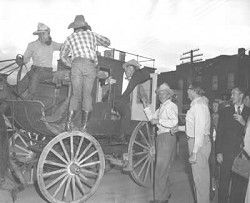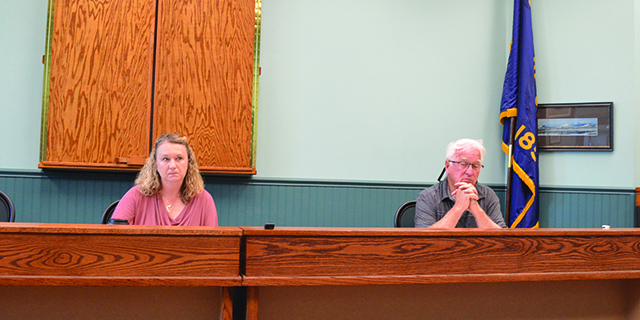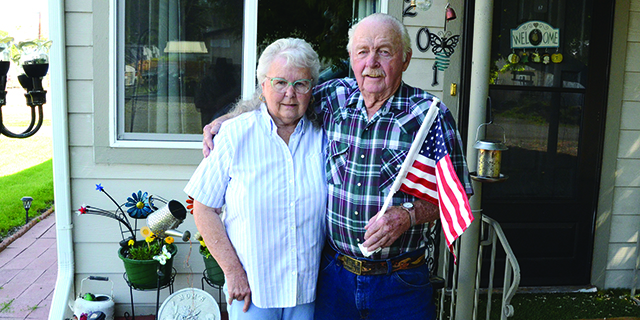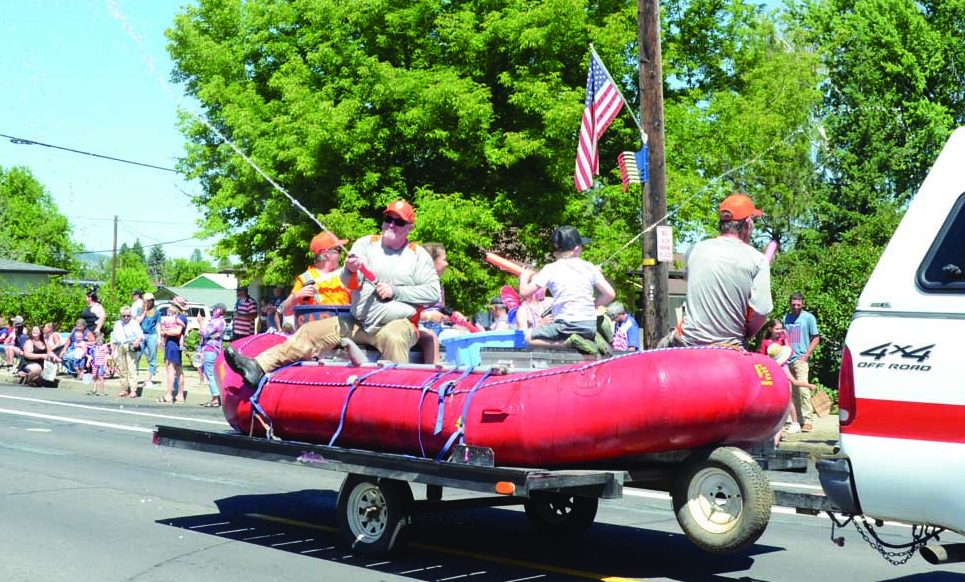Chief Joseph Days roots stretch back to 1946 airport dedication
Published 5:00 pm Tuesday, July 15, 2008

- Chief Joseph Days roots stretch back to 1946 airport dedication
Joseph’s big Chief Joseph Days celebration is centered around the rodeo every year, but it didn’t start out that way.
According to a search through the annals of the Wallowa County Chieftain, the event was actually conceived in 1946 as a way to dedicate the new Joseph State Airport.
Although a rodeo was held as part of that first celebration, it was only one of many activities going on during an exciting weekend.
The first mention of plans for the occasion, sans rodeo, was found in this account from the April 25, 1946, issue of the Chieftain:
“A big three-day celebration sponsored by the Joseph Chamber of Commerce is being planned for July 26, 27 and 28 in connection with a program to dedicate the Joseph municipal airport as a memorial to the veterans of World War II.
“The celebration will be known as ‘Chief Joseph Days’ and is being planned along lines that will bring out all the color of the old and the new West.
“Plans call for a horse show, saddle horse sale, dancing, numerous concessions, a ‘Happy Canyon’ show modeled along the lines of the Happy Canyon at Pendleton Round-Up, an air show and numerous other entertainment features.
“Numerous outside riding clubs will be contacted in addition to local horsemen in an effort to put on a real horse show. A saddle horse sale is expected to draw a large number of fine saddle horses to the event.
“Flying clubs and other organizations interested in aviation are being invited to send in planes to put on a gala air show in connection with the dedication ceremonies at the airport.
“One of the highlights will be the selection of ‘Princess Josephine’, who will rule over the three days of activities. The princess will be selected from a list of candidates in a popularity contest, the details of which will be announced at a later date.
“Indian tribes from nearby reservations will be invited to the celebration and it is expected that their camps, costumes, dances and other activities will lend a good deal of color and interest to the event.
“The theme of the celebration will be the history of the Nez Perce Indians and their leader, Chief Joseph, which have been the subject of song and story for many years.
“If the show is well received, it is hoped that it can be made an annual event which will become as famous as other well-known celebrations in the West.”
Although it wasn’t mentioned as part of the initial plans, there was indeed a rodeo that first year – held on Sunday afternoon on top of the east moraine of Wallowa Lake. Harley Tucker, who later became one of the top rodeo contractors in the West, and his then-partner Ben Peel, provided the stock.
For the second Chief Joseph Days in 1947, a large number of volunteers built a rodeo arena in Joseph at its present-day site, and rodeo competition became the centerpiece of the celebration.
Here, in a nutshell, is how the first Chief Joseph Days gala unfolded, as reported by the Chieftain:
Friday, July 26, 1946 – noon, penny scramble for the kids; 2 p.m., baseball game; 9 p.m., dancing at Hells Canyon Dance Hall (an outdoor affair), featuring the Nez Percians, a 10-piece Nez Perce Indian dance band in native costume.
Saturday, July 27 – 10 a.m., big parade; 11 a.m., drill team demonstrations; 2 p.m., Joseph airport dedication and air show, featuring stunt flying, parachute jumping, demonstrations of new aircrafts and passenger rides; 5 p.m. saddle horse show at Joseph Livestock yards; and a dance “until the wee hour,” with the climax coming with the announcement of the first CJD Court – Queen Icel Edgmand and Princesses Mina Drake and Carmen Turnbow (the title “Princess Josephine” didn’t survive long) after a hard-fought contest. Winners of the “Whiskeroo” (beard-growing) contest were also announced.
Sunday, July 28 – morning, cowboy breakfast at Wallowa Lake; 11 a.m., “manhunt” with $100 going to the winner; 2 p.m., rodeo at Lake Hill rodeo grounds; and a baseball game.
A carnival operated all three days.
Although the focus of the celebration has evolved, volunteers continue to strive to keep the excitement and spirit of that first Chief Joseph Days alive.
This humorous perspective of the sport of rodeo was published in the Wallowa County Chieftain on July 29, 1948, just before the third annual Chief Joseph Days.
It was written by the late Gwen Coffin, a former Illinois lawyer who was the Chieftain’s editor/publisher from 1941 to 1971. Coffin continued to write for the paper until his death in 1994 – one year after he was inducted into the Oregon Newspaper Association Hall of Fame.
Bring on the bull
One of the strange things in these unusual times is that while there is a shortage of applicants for such pleasant and profitable professions as bricklayers, barbers and butlers, the brush is full of buckaroos. No one ever heard of a rodeo quitting because bronc busters were on strike for shorter rides on smaller ponies.
Maybe John L. Lewis hasn’t got around to organizing the boys yet. Perhaps when the International Brotherhood of Buckaroo is organized we will see considerable “improvements” made in his ancient art of wrestling with wild horses. Possible then the employment contracts between rodeo producers and bronc riders will provide for portal to portal pay with pensions for buckaroos with broken backs and squashed skulls.
It is peculiar how women who can’t stand the sight of a mouse or a cut finger hang on to their seats with excitement when some fellow climbs in a chute with a wild horse bent on killing somebody if it can.
Boy, this is a sport! Look at the fellows trying to get a saddle on the snorting critter. Someone is going to get the stuffing knocked out of him on this horse.
The gate is open! Here he comes! The rider is waving his hat with one hand and holding the rope with the other. See how happy he looks. You can tell by the serene look on his face that he is having the time of his life. If the four-legged pack of dynamite he is riding doesn’t fall down, crash into the fence, rare over backwards or pitch him over its head and trample on him, he will be home with the wife and kiddies again tonight. If he rides out the contest, he may get some applause from the crowd, but if he is thrown and run over the spectators applaud the horse and cant wait until someone else tries him.
Most of these bucking horses are wild enough to start with. They have been goaded into bucking until they have no use for mankind. But to make sure that they will not be half-hearted in their man-killing impulses, the rodeo handlers cinch up tight strap around their flanks, slap them at wave at them with everything handy, hoping to make them ornerier than they want to be.
And the rider isn’t supposed to hold on. The idea isn’t for him to do his best to ride the horse while the horse is doing his best to throw him.
No, the idea is that a 150-pound man is too much of a match for a 1,500-pound horse, so the man has to be placed under a handicap. He mustn’t hold on and he is supposed to spur the horse into his worst (or best!) efforts. After all, we want quite a few fellows to get thrown in this business to keep the audience satisfied.
Not content with riding wild horses, some fellows have taken to riding wild bulls. And the bulls in this country not being ferocious enough for good clean sport, the rodeos have gone to India to import animals which reach maturity only if they are able to fight off man-eating and bull-eating tigers from the time they are day-old calves.
To make the game even more exciting, they put a man on one of these 2,000-pound bulls without a saddle.
They leave the bull’s horns on too, just in case a rider might be inclined to take it easy when he gets thrown. With the bull pawing at him and trying to run him through with a horn, the rider is sure to scramble for escape to the best of his ability. There won’t be any stalling or showing off, such as boxers indulged in on occasions. Whatever happens will be in earnest all right.
If they wanted to give the bull rider a real chance, they should strap a sword on his belt. Then if the bull pitched him to the ground he could pull his saber and stage a real bullfight. Anyway, it is a lot of sport and a real opportunity for somebody – for somebody else, that is.






